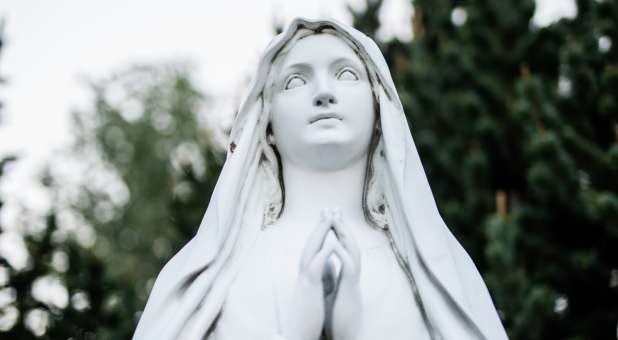Believing in Jesus Christ and His miraculous birth does not require the so-called “blind leap of faith,” for there is as much evidence for the virgin birth of Christ as any event of ancient history. It is not lack of evidence that keeps people from believing in the virgin birth, but a predisposed bias against the possibility of miracles.
Here are six compelling reasons for believing that Jesus Christ was supernaturally born of a virgin. His birth was:
- Documented by a physician and world-class historian.
- Confirmed by modern archaeology.
- Confirmed by an agnostic professor.
- Predicted by Old Testament prophets.
- Believed universally by the earliest Christians.
- Confirmed by His amazing world impact.
1. Documented by a physician and world-class historian.
At the beginning of his Gospel, Luke, whom Paul calls “the beloved physician” in Colossians 4:14, indicates that he has made a thorough investigation of the things about which he is writing, including the virgin birth.
This investigation included his utilization of eyewitness accounts of the events described. Luke spent extended periods of time with Paul in Jerusalem and Judea and would have had the opportunity to interview those who were closest to the event, including Mary herself.
Of all the Gospels, Luke gives the most detailed account of the nativity and mentions Mary 12 times, more than any other biblical writer. In addition to the birth of Christ, he also gives special, detailed attention to the birth of John the Baptist, and many see his gynecological interests to be a result of his training as a physician.
There is no reliable information on how long Mary lived, but some traditions say she lived as long as 24 years or longer after the resurrection. The detail Luke presents does indicate that he has derived his information from a primary source, either Mary herself or someone to whom Mary had relayed the intimate details of the event.
At one time, it was thought that Luke was mistaken concerning the events he portrayed surrounding the birth of Christ (Luke 2:1-5). Critics argued that there was no census and that everyone did not have to return to their ancestral home. They also pointed out that Josephus had dated the governorship of Quirinius of Syria, whom Luke mentions, as beginning in A.D. 6, too late for the birth of Christ.
In every case, however, modern archaeological discoveries have proved the critics to be wrong. In the case of Quirinius, it was found that he actually served two separate terms as governor, the first beginning around 7 B.C., which fits perfectly with the time of Christ’s birth. The late F. F. Bruce, one of the most respected of New Testament scholars, noted that where Luke has been suspected of inaccuracy by modern critics, archaeology has again and again proved Luke to be right and the critics wrong.
The accuracy of Luke as a historian was confirmed by the famous historian, A.N. Sherwin-White, who carefully examined his references in Luke/Acts to 32 countries, 54 cities and nine islands, finding not a single mistake.
Challenging the claims of critics that the story of the virgin birth was based on a hoax, the noted Greek scholar, Professor John A. Scott, reminded the naysayers of Luke’s training as a physician and his reputation as a historian. Pointing to his attention to detail and accurate reporting, Scott declared, “You could not fool Doctor Luke.”
2. Affirmed by modern archaeology.
Luke’s status as a world-class historian, accurate in even the smallest details, has been brought to light by modern archaeology. For example, Sir William Ramsay, considered one of the greatest archaeologists of all time, originally thought he would scientifically discredit Luke’s accounts by visiting and examining the places mentioned in his Gospel and Acts.
Ramsay, an Oxford professor, was a product of the skeptical, German higher criticism of the 19th century, and he taught that the New Testament is an unreliable religious treatise written in the mid-second century by individuals far removed from the events described. But after years of retracing Luke’s account of Paul’s travels and doing archaeological excavations along the way, Ramsay completely reversed his view of the Bible and first-century history.
Ramsay became convinced that Acts was written in the first century by the traditional author, and he acquired a very high regard for Luke as a historian. He wrote,
“Luke is a historian of the first rank; not merely are his statements of fact trustworthy, he is possessed of the true historic sense; in short, this author should be placed along with the greatest of historians.”
In 1896, Ramsay began publishing his discoveries in a book entitled St. Paul the Traveler and the Roman Citizen. The book caused a furor of dismay among the skeptics of the world, for its affirmation of the biblical record was totally unexpected. The evidence was, in fact, so overwhelming that many atheists gave up their atheism and embraced Christianity.
Over the next 20 years, Ramsay published other volumes showing how he discovered Luke to be accurate in the tiniest details of his account. In his book, The Bearing of Recent Discovery on the Trustworthiness of the New Testament, he wrote, “You may press the words of Luke in a degree beyond any other historian’s and they stand the keenest scrutiny and the hardest treatment.”
Archaeology has, indeed, affirmed, not only Luke, but the entire biblical account. William F. Albright, renowned archaeologist and late professor of Semitic languages at John Hopkins University spent many years leading archaeological excavations in the land of the Bible. He wrote, “Discovery after discovery has established the accuracy of innumerable details, and brought increased recognition to the Bible as a source of history.”
The evidence begs the question that if Luke was this careful to get his facts right about names, places, events and dates, can we not be confident that he was just as careful to get his facts right concerning the more important things about which he reported, such as the virgin birth of Jesus Christ?
3. An agnostic professor of mythology is convinced.
C.S. Lewis was the agnostic professor of Renaissance literature at Oxford University, a prolific author and a recognized expert of mythological texts. He too had bought into the idea that the Bible was not a book of reliable history and that the New Testament was filled with all sorts of mythical stories, created by individuals far removed from the events described.
But through the influence of his childhood, and friends who challenged his agnosticism, Lewis began to read the Bible. He was astounded at what he encountered in the Gospels, for it was obviously a different genre from the ancient mythologies with which he was so familiar. His surprised response was, “This is not myth!” Lewis went on to become a dedicated follower of Christ and perhaps the most significant Christian apologist of the 20th century.
At the time, higher criticism was being popularized in German seminaries. Certain theologians, such as Rudolph Bultmann, were claiming that the New Testament accounts of the virgin birth of Jesus, His miracles and His resurrection were myths created by His followers.
Lewis challenged these theologians, saying, “I would like to know how many myths these people have read!” He went on to explain that he had been a long-time professor and critic of mythological literature and knew how a myth sounded and felt. “And the gospel story,” he said, “Is not myth!”
4. Predicted centuries in advance by Old Testament prophets. Genesis 3:15 reads, “I will put enmity between you and the woman, and between your offspring and her offspring; he will bruise your head, and you will bruise his heel.”
These words were spoken by God to the serpent after the fall of our first parents. The “seed of the woman” in this passage is an allusion to a future descendant of Eve who will defeat the serpent and reverse the curse brought on by his deception.
The Bible normally speaks of the seed of men, but in this case, it is the “seed of the woman.” This is a prophecy that clearly anticipates the future virgin birth of Christ—a birth in which the seed of a man is not involved. The Methodist theologian, Adam Clarke, wrote in The Holy Bible Containing the Old and New Testaments with a Commentary and Critical Notes, “The seed of the woman is to come by the woman, and her alone without the concurrence of man.”
According to this prophecy, the “seed of the woman” will receive a temporary wound from Satan—”you will bruise His heel”—but the “seed of woman” shall inflict on Satan a final and mortal wound—”He will bruise your head.” This Messianic promise was fulfilled through the virgin birth of Jesus and through His death and resurrection.
Isaiah 7:14 says, ” Therefore the Lord Himself shall give you a sign: The virgin shall conceive, and bear a son, and shall call his name Immanuel.” The Hebrew word translated “virgin” in this passage is almah and refers to a young woman of marriageable age, but would normally include the idea of virginity, since that was expected of a young Jewish woman being married for the first time.
That “virgin” is an accurate English translation is confirmed by the Septuagint, which uses the Greek word parthinos to translate almah. Parthinos specifically means a young woman who has never had sex with a man. Parthinos is the word used by both Matthew and Luke in their description of Mary, affirming that she was a young woman who had never had sex with a man when Jesus was born.
Further evidence that Isaiah 7:14 is a Messianic prophecy referring to Jesus Christ is indicated by Isaiah’s statement that he shall be called “Immanuel,” which means “God with us.” This is a clear statement concerning the incarnation of God in Jesus Christ and reminds us of the words of Gabriel to Mary that the Son she will bear “will be great, and will be called the Son of the Highest” (Luke 1:32a).
5. Believed universally by the earliest Christians.
That the virgin birth was universally believed by the earliest Christians is verified, not only by the gospel record, but also by the Apostles’ Creed. The Apostles’ Creed is an early confession of faith that dates from the second century and was used throughout the universal church. By including the virgin birth in their creedal statement, these early believers made clear that they considered it an essential doctrine of the faith. The creed reads in part:
I believe in God the Father Almighty, maker of heaven and earth; and in Jesus Christ his only Son our Lord: Who was conceived by the Holy Spirit, born of the Virgin Mary (emphasis added).
This earliest belief in the virgin birth was confirmed by the Nicene Creed of A.D. 325 and has continued to be the belief of Catholic, Eastern Orthodox and Protestant Christians everywhere.
Note the words of the 18th-century hymn, “Hark the Herald Angels Sing,” written by Charles Wesley, an Oxford graduate and Anglican minister, and with his brother, John, the leader of the great Methodist revival. Because of the references to the virgin birth, this hymn became a popular carol sung at Christmas:
“Christ by highest heav’n adored, Christ the everlasting Lord!/ Late in time behold Him come, offspring of a Virgin’s womb!/ Veiled in flesh the godhead see, hail the incarnate Deity!/ Pleased as man with man to dwell, Jesus our Emanuel!/ Hark the herald angels sing, glory to the newborn King!”
6. His amazing world impact.
There is no question that Jesus Christ is the most influential person to ever occupy this planet. His influence touches all races, classes and tongues from Jerusalem to Timbuktu, from Nairobi to Brasilia and from London to Beijing.
This influence was immediate, with his first followers willing and anxious to give their lives to spread the Good News of His miraculous birth, life, death and resurrection. That same life-and-death commitment has continued with His followers through the centuries. Napoleon Bonaparte said of Jesus Christ,
I know men, and I tell you that Jesus Christ is no mere man. Between Him and every other person in the world there is no possible term of comparison. Alexander, Caesar, Charlemagne and I have founded empires. But on what did we rest the creation of our genius? Upon force. Jesus Christ founded His empire upon love; and at this hour, millions of men would die for Him.
The noted historian, Philip Schaff captured this influence well in the following statement.
Jesus of Nazareth, without money and arms, conquered more millions than Alexander the Great, Caesar, Mohammed, and Napoleon; without science and learning, he shed more light on things human and divine than all philosophers and scholars combined; without the eloquence of school, he spoke such words of life as were never spoken before or since, and produced effects which lie beyond the reach of orator or poet; without writing a single line, he set more pens in motion, and furnished themes for more sermons, orations, discussions, learned volumes, works of art, and songs of praise than the whole army of great men of ancient and modern times.
How are we to explain the influence of this one individual born in a stable in a small insignificant town in the Middle East? There is only one explanation, and the writer of the following Christmas hymn has captured it well:
“O little town of Bethlehem, how still we see thee lie/ Above thy deep and dreamless sleep, the silent stars go by/ Yet in thy dark streets shineth, the everlasting light/ The hopes and fears of all the years, are met in thee tonight.”
Conclusion
Such overwhelming evidence for the virgin birth of Jesus Christ raises the question as to why there remains so much skepticism about this event and other miracles recorded in the New Testament. This question was answered by Yale archaeologist and professor, Millard Burrows, who said, “The excessive skepticism of many liberal theologians stems not from a careful evaluation of the available data, but from an enormous predisposition against the supernatural.”
In other words, the barrier to faith is not an intellectual one, but a heart that is committed to unbelief. Any honest seeker who will lay aside their biased presuppositions and consider the historical evidence will also experience the affirming witness of the Holy Spirit in their heart and will know that Jesus Christ was truly born of a virgin. And if that part of the story is true, then we can have confidence that the rest of the story is true as well. {eoa}
This article is derived from Dr. Eddie Hyatt’s latest book, Christmas is for Real, with the subtitle, Historical Evidence for the Virgin Birth of Jesus Christ, available from Amazon and his website at eddiehhyatt.com.
See an error in this article?
To contact us or to submit an article






















